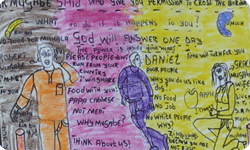The reality of the global refugee crisis
 Dr Larry Stillman
Dr Larry Stillman
Public perception of refugees causes razor sharp public anxiety with every boat arrival. Yet after rigorous scrutiny by the UN High Commissioner for Refugees or Australia’s Immigration Department, the vast majority of asylum seekers can in fact be classified as genuine refugees. Australia’s situation must be also seen from a global perspective.
The five or ten thousand people who come to Australia in this way are just a drop in the ocean of global population movements. These movements are an international reality from which Australia, one of the world’s most affluent countries, cannot be isolated.
I am starting to experience the reality of the international refugee crisis. In South Africa there are at least one million refugees, who have fled countries such as Zimbabwe. In total there are at least 17 million refugees in Africa, similar to Australia’s entire population. Many of the refugees in South Africa live in tin-shack shantytowns, some of the most squalid and heart-rending conditions imaginable.
Just down the road from Monash University’s South Africa campus is the Zandspruit ‘informal settlement’. It wouldn’t surprise me if the film District 9 had been made there. At least 50,000 people live here cheek by jowl, inhabiting hovels the size of garden sheds, without running water, electricity or proper sewerage. There are piles of garbage.
Fleas and lice are endemic and then there are the rats. There are only a couple of health clinics here, each with huge queues of mothers and babies desperate for basic health care. If someone is seriously ill, ambulances cannot get into the camp because roads are almost non-existent and the laneways are tiny. Instead, people must be piled into wheelbarrows and brought out.
The chances of dying en route are high. It is bad enough when it rains, but when there is a downpour — like tonight, when I drove home to middle-class comfort — Zandspruit becomes a sea of filth and mud. Because of the struggle to survive, Zandspruit is very violent and there have even been killings.
There are some non-government organisations involved in supporting the community. The people who work for the NGOs are extraordinary, and the local white councillor, who at first sight seems like a relic of the apartheid regime, is an ANC member and a tireless advocate on their behalf.
Monash University gives homework assistance to 200 children and runs fun activities every Saturday morning, and I am involved in an IT project. Amazingly, some of these kids are even making it to university despite their struggles. And you know how many refugees live in the camp? Fifty thousand. That’s probably five times the total number of ‘illegals’ who come to Australia each year by boat.
I have gone into such detail because it is easy to forget how horrible life can be for people whose displacement is no fault of their own, just as it is easy to fall into cold governmental language that dehumanises ‘unjustified’ refugees. Just as the Nazis found good use for bureaucratic language to rationalise their hatred, Australians have a penchant for a similar characterisation of supposed enemies, aided by politicians and enthusiastic bureaucrats who play the worst sort of dog-whistle politics.
The number of people who get to Australian ‘illegally’ is tiny compared with what happens in the rest of the world, and we can afford not only to treat them better, but also to massively invest in civil reconstruction and development abroad so that they needn’t flee in the first place.
Dr Larry Stillman is a Liberty committee member and Monash University academic. These views are his own, not those of the university.
